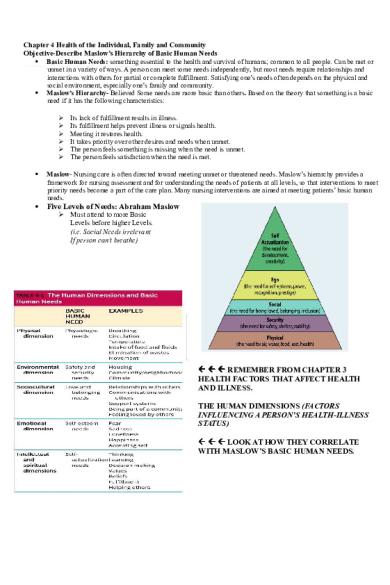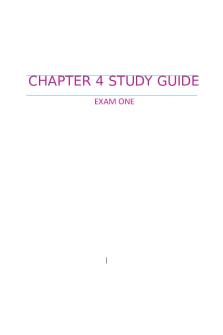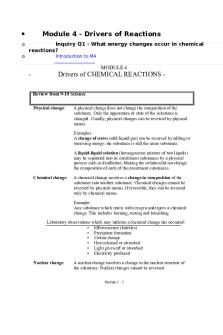Chapter 4 Study Guide PDF

| Title | Chapter 4 Study Guide |
|---|---|
| Author | Anonymous User |
| Course | Nursing II |
| Institution | Union County College |
| Pages | 4 |
| File Size | 305.3 KB |
| File Type | |
| Total Downloads | 48 |
| Total Views | 175 |
Summary
N120 Chapter 4 Study Guide...
Description
Chapter 4 Health of the Individual, Family and Community Objective-Describe Maslow’s Hierarchy of Basic Human Needs Basic Human Needs: something essential to the health and survival of humans; common to all people. Can be met or unmet in a variety of ways. A person can meet some needs independently, but most needs require relationships and interactions with others for partial or complete fulfillment. Satisfying one’s needs often depends on the physical and social environment, especially one’s family and community. Maslow’s Hierarchy- Believed Some needs are more basic than others. Based on the theory that something is a basic need if it has the following characteristics:
Its lack of fulfillment results in illness. Its fulfillment helps prevent illness or signals health. Meeting it restores health. It takes priority over other desires and needs when unmet. The person feels something is missing when the need is unmet. The person feels satisfaction when the need is met.
Maslow- Nursing care is often directed toward meeting unmet or threatened needs. Maslow’s hierarchy provides a framework for nursing assessment and for understanding the needs of patients at all levels, so that interventions to meet priority needs become a part of the care plan. Many nursing interventions are aimed at meeting patients’ basic human needs.
Five Levels of Needs: Abraham Maslow Must attend to more Basic Levels before higher Levels. (i.e. Social Needs irrelevant If person can’t breathe)
REMEMBER FROM CHAPTER 3 HEALTH FACTORS THAT AFFECT HEALTH AND ILLNESS. THE HUMAN DIMENSIONS (FACTORS INFLUENCING A PERSON’S HEALTH-ILLNESS STATUS) LOOK AT HOW THEY CORRELATE WITH MASLOW’S BASIC HUMAN NEEDS.
APPLYING MASLOW’S THEORY REMEMBER NURSING PROCESS (ADPIE)
Nurses can apply Maslow’s hierarchy of basic needs in the Assessment, Planning, Implementation, and Evaluation of patient care. The hierarchy can be used with patients at any age, in all settings where care is provided, and in both health and illness. It helps the nurse identify unmet needs as they become health care needs. The hierarchy of basic needs allows the nurse to locate the patient on the health–illness continuum and to incorporate the human dimensions and health models into meeting needs. REVIEW CHAPTER 3 HEALTH OF THE IDVIDUAL, FAMILY AND COMMUNITY
The Family Family: Religious, relatives, friends Nuclear Family: Can be homosexual, married, not married, adoption. Blended: two people bring their own children Extended: Aunts, uncles, grandparents Binuclear: Divorced parents assume joint custody of children. Dyadic Nuclear: The couple chooses not to have children. Cohabitation Families: Living under the same roof for financial purposes, relationship & changing values. The Family in Health and Illness- People learn health care activities, health beliefs, and health values in the family. When patients enter the health care system, they bring their own personal behaviors and needs, but they also bring (in a sense) their family too. Importance of family-centered nursing care (four ways). First, the family is composed of interdependent members who affect one another. If some form of illness occurs in one member, all other members become involved in the illness. Second, because there is a strong relationship between the family and the health status of its members, the role of the family is essential in every level of nursing care. Third, the level of health of the family and in turn each of its members can be significantly improved through health promotion activities. Fourth, illness of one family member may suggest the possibility of the same problem in other members.
Risk factors for Altered Family Health Lifestyle Risk Factors Lack of knowledge about sexual and marital roles, leading to teenage marriage and pregnancy; divorce; sexually transmitted infections; child, spouse, or elder abuse; and lack of prenatal or childcare Alterations in nutrition—either more or less than body requirements at any age Chemical dependency, including the use of alcohol, drugs, and nicotine Inadequate dental care and hygiene Unsafe or unstimulating home environment Psychosocial Risk Factors Inadequate childcare resources, for preschool and school-aged children Inadequate income to provide safe housing, food, clothing, and health care Conflict between family members Environmental Risk Factors Lack of knowledge or finances to provide safe, clean living conditions Work or social pressures that cause stress Air, water, or food pollution Developmental Risk Factors Families who have new babies, especially if support systems are unavailable Older adults, especially those living alone or on a fixed income
Unmarried adolescent mothers who lack personal, economic, and educational resources Biologic Risks Birth defects Intellectual disability Genetic predisposition to certain diseases, including cardiovascular diseases and cancer
The Community Objective- Differentiate between community based and community focused health care Community focused nursing focuses on whole populations Community-based -nursing focuses specifically on the individuals and the families within the population. Many characteristics of a community influence the health of its members. This diagram shows six categories of characteristics that influence the health of a member of a community.
Objective – Explain common health problems in the community. Just as there are family risk factors for the health of individual members, there community risk factors involving resources, economics, and services. For nursing assessments and interventions to be comprehensive and individualized, the nurse must consider the community’s influence.
Common Health problems Number and availability of health care institutions and services Housing codes Nutritional services for low-income infants, mothers, school-aged children (e.g., lunch programs), and older adults Zoning regulations separating residential and industrial areas Waste disposal services and locations Air and water pollution Food sanitation Health education services and dissemination Employment opportunities Recreational opportunities Violent crimes or drug use Objective- Correlate how nursing strategies promote health in the community Nursing care provided within a community must be culturally competent and family centered. Nurses providing community-based care must know about the location and specialties of health care providers, the availability and accessibility of services and supplies, and other public health services. Additional considerations include facilities (such as daycare or long-term care), housing, and the number and type of facilities providing services. Nurses promote health as individuals, as caregivers within institutional settings, and as community-based health care providers. Nurses also provide community services as volunteers in health-related activities (e.g., screenings, educational programs, and blood drives) and as role models for health practices and lifestyles. CHAPTER 4 Key Concepts
Meeting basic human needs is essential to the health and survival of all people. Abraham Maslow developed a hierarchy of basic human needs. Physiologic needs that must be minimally met include oxygen, water, food, elimination, temperature, sexuality, physical activity, and rest. Safety and security needs are the next priority, which involve both physical and emotional components. Love and belonging needs include the understanding and acceptance of others in both giving and receiving love, as well as the feeling of belonging to families, peers, friends, a neighborhood, and a community. Self-esteem needs include the need for a person to feel good about oneself, to feel pride and a sense of accomplishments, and to believe that others also respect and appreciate those accomplishments. Self-actualization needs are the highest level on the hierarchy and include the need for individuals to reach their full potential through development of their unique capabilities. A family is a group of people who live together and depend on one another for physical, emotional, or financial support. Family structures include nuclear families, single-parent families, and other nontraditional family structures. Family patterns of behavior, the environment in which the family lives, and genetic factors can all place family members at risk for health problems. A community is a specific population or group of people living in the same geographic area under similar regulations and having common values, interests, and needs. Nurse-managed centers in communities offer high-quality care to underserved populations in a costeffective manner....
Similar Free PDFs

Chapter 4 Study Guide
- 4 Pages

Chapter 4 Study Guide
- 11 Pages

Chapter 4 Study Guide
- 9 Pages

Chapter-4 study guide
- 45 Pages

Chapter 4 Study Guide
- 9 Pages

Chapter 4 Study Guide
- 4 Pages

Study Guide for Chapter 4
- 4 Pages

Chapter 4 Review - study guide
- 7 Pages

Study guide chapter 4 exam 1
- 8 Pages

Exam 4 Study Guide
- 22 Pages

Module 4 study guide
- 36 Pages
Popular Institutions
- Tinajero National High School - Annex
- Politeknik Caltex Riau
- Yokohama City University
- SGT University
- University of Al-Qadisiyah
- Divine Word College of Vigan
- Techniek College Rotterdam
- Universidade de Santiago
- Universiti Teknologi MARA Cawangan Johor Kampus Pasir Gudang
- Poltekkes Kemenkes Yogyakarta
- Baguio City National High School
- Colegio san marcos
- preparatoria uno
- Centro de Bachillerato Tecnológico Industrial y de Servicios No. 107
- Dalian Maritime University
- Quang Trung Secondary School
- Colegio Tecnológico en Informática
- Corporación Regional de Educación Superior
- Grupo CEDVA
- Dar Al Uloom University
- Centro de Estudios Preuniversitarios de la Universidad Nacional de Ingeniería
- 上智大学
- Aakash International School, Nuna Majara
- San Felipe Neri Catholic School
- Kang Chiao International School - New Taipei City
- Misamis Occidental National High School
- Institución Educativa Escuela Normal Juan Ladrilleros
- Kolehiyo ng Pantukan
- Batanes State College
- Instituto Continental
- Sekolah Menengah Kejuruan Kesehatan Kaltara (Tarakan)
- Colegio de La Inmaculada Concepcion - Cebu




